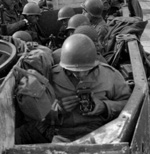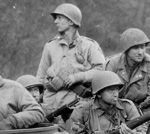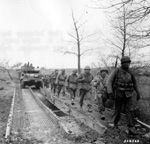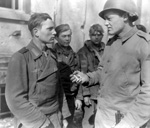New, Arctic M41 Jacket. These were a heavier version of the "olive drab field jacket" (M41), lengthened to cover the hips, made from heavier cotton twill and the same lining as Tankers and Mackinaw coats. Initially these were intended for issue in arctic climates such as Alaska, Iceland and Scandinavia- they were used by the 1 Special Service Force due to their use in the Aleutian campaign. A number of other soldiers acquired them, by various means, as they were prized second only the the tanker jackets due to their better thermal qualities. Command indecision and turf wars amongst the American senior officers led to a shortage of new M43 field jackets in the Fall of '44 which led to a mass issue of any remaining stocks of M41's, Arctic M41's and Mackinaws in October of that year. So, by the Battle of the Bulge, these jackets were very common in the ETO. (For more details see below)
Our Arctics were copied from an mint, unissued 40R in our collection. The shell is 100% cotton twill, in the correct olive drab #3 shade. Lining is heavy, mustard brown 70/30 wool. We duplicated all the details, down to the spec label and half sized slides peculiar to these coats. Zippers are genuine Talon brand and right opening. These coats are exclusive to ATF and are not sold by any other company.
Sizing: No secret decoder ring or fancy formulas are necessary. Order your normal chest size- our sizes also correspond to those of most modern retailers like Gap, J.Crew or LL Bean. These are made with plenty of room to allow for layers of other clothes underneath. Sleeves on all sizes are approximately 25".
Washing Instructions: Dry Clean Only! The lining is wool. 70/30%. It is possible to hand wash in cold water and hang dry. But that means literally by hand, in the sink or a tub. Not on "gentle" cycle in the Maytag.
Arctic M41's in the ETO
|

|

|

|

|
|
All photos NARA
|
|
Soldiers 1, 2, 4 and 5
|
|
In the Fall of 1944, there was a winter uniform supply crisis brought on by squabbling between the Army Quartermaster, War Production Board, and the officers in the ETO, notably Eisenhower and Bradley. The latter prefered the ETO (Ike) Jackets as a replacement for the M41 jackets, while the QM had decided on the M1943 Field Jacket. This led to production and procurement delays throughout 1944 resulting in a severe shortage of either uniform by the end of the summer. In October, an emergency shipment of 245,239 M41's, 457,741 Arctic M41's and 797,000 Service coats was sent to Europe. The service coats were deemed not acceptable for combat...(The Quartermaster Corps: Operations in the war against Germany, pg. 590, Library of Congress).
This explains why these coats are not difficult to find in photos of US troops in the last 6 months of the War. At first glance, they can be confused for a regular M41 (due to the collar and slash pockets) or an M1943 (due to their length). Look for the 1" wide straps and buckles on the cuffs- no other uniform has those.
Insignia Recommendations:
In garrison, stateside or training in England, the unit shoulder patch and rank insignia was normally worn. Awards were rarely seen, aside from an occasional CIB or Jump Wing pinned on- but this is very unusual. (I have NEVER, EVER seen embroidered awards on an M41.)
For combat troops, no insignia is most typical. Yes, I'd make more money encouraging people to cover their field jackets with all sorts of bling, but it's not correct. By the book, rank and unit patches could (and should have been) on these. However, once the shooting started, big, bright unit patches were found to be a liability. I can personally attest to the ease with which one can spot a 2nd, 45th, or 101st patch at great distances.( I've re-enacted the bad guys since 1981...)
From examining period photos and film, it appears that many units initially wore their insignia into combat- for example, on the LCI's on June 6th, 1944. But after some encounters with the enemy, those pretty patches tend to become scarce. Like by noon on June 7th, 1944. Albeit, a few units seem to have retained their insignia for one reason or another more so than others. If you're trying to do a truly accurate impression, I recommend that you research your specific unit of interest before deciding.
Which Rank Chevrons to wear? The historically correct answer is- all 5 variations.
1. No chevrons. (Most combat troops knew their NCO's faces and voices- rank insignia attracts snipers.)
2. Rayon (Most typical & idealized by living historians)
3. Wool
4. Khaki cotton (designed to be worn on the khaki summer service shirt, but sometimes they are seen on field jackets.)
5. Black Ink (There were actually stencil kits issued with a bottle of ink and a brush. Oftentimes they were done freehand.)